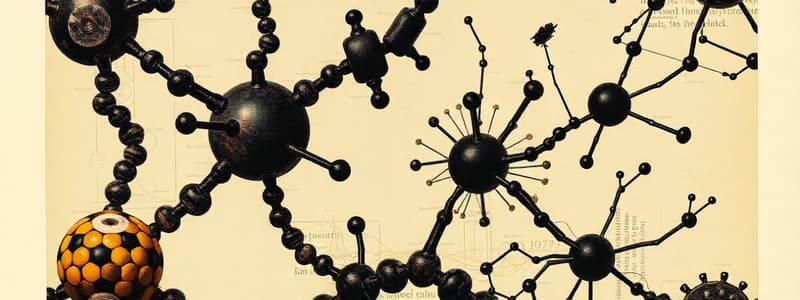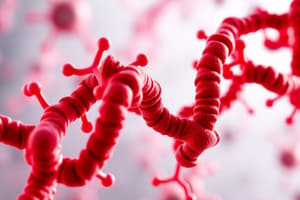Podcast
Questions and Answers
What is the primary function of the Surface Plasmon Resonance Angle in the context of ligand binding?
What is the primary function of the Surface Plasmon Resonance Angle in the context of ligand binding?
- It measures the binding constant of interactions between ligands. (correct)
- It provides information about the temperature at which binding occurs.
- It determines the structural integrity of the ligand.
- It analyzes the molecular weight of the ligand in real-time.
Which of the following statements correctly describes the role of E1 and E2 proteins in HPV DNA replication?
Which of the following statements correctly describes the role of E1 and E2 proteins in HPV DNA replication?
- E1 is involved in the recruitment of E2 to the viral origin. (correct)
- Both E1 and E2 proteins are identical in size and function.
- E2 protein is solely responsible for initiating DNA synthesis.
- E1 protein has no significant interaction with E2 during replication.
How are inhibitors or blockers of Protein-Protein interactions significant in therapeutic development?
How are inhibitors or blockers of Protein-Protein interactions significant in therapeutic development?
- They specifically target cancer-only proteins and ignore other interactions.
- They can intervene in aberrant associations associated with various diseases. (correct)
- They can completely eliminate the need for further research.
- They are exclusively used for treating viral infections.
What is a characteristic feature of the Condylomata resulting from HPV infection?
What is a characteristic feature of the Condylomata resulting from HPV infection?
What common characteristic do many human diseases share regarding Protein-Protein interactions?
What common characteristic do many human diseases share regarding Protein-Protein interactions?
Which of the following methods is NOT used to detect protein binding efficiency?
Which of the following methods is NOT used to detect protein binding efficiency?
In the STRING protein interaction network, what does a thicker line between two proteins indicate?
In the STRING protein interaction network, what does a thicker line between two proteins indicate?
What characteristic change occurs in the fluorescence intensity of a labeled protein when it binds to an unlabeled protein?
What characteristic change occurs in the fluorescence intensity of a labeled protein when it binds to an unlabeled protein?
What is the primary purpose of using the Co-immunoprecipitation (Co-IP) method?
What is the primary purpose of using the Co-immunoprecipitation (Co-IP) method?
How does the fluorescence method allow for the detection of protein interactions?
How does the fluorescence method allow for the detection of protein interactions?
Which gene encodes the beta subunit of Tryptophan Synthase in the bacterial Tryptophan pathway?
Which gene encodes the beta subunit of Tryptophan Synthase in the bacterial Tryptophan pathway?
Which binding detection method is characterized as a label-free approach?
Which binding detection method is characterized as a label-free approach?
Which of the following proteins is involved in the Tryptophan pathway and acts as a tryptophanase?
Which of the following proteins is involved in the Tryptophan pathway and acts as a tryptophanase?
What is the role of the E1 and E2 proteins in Papilloma virus infection?
What is the role of the E1 and E2 proteins in Papilloma virus infection?
Which of the following proteins is a subunit of Dihydro Folate Synthase in bacteria?
Which of the following proteins is a subunit of Dihydro Folate Synthase in bacteria?
Flashcards
Surface Plasmon Resonance (SPR)
Surface Plasmon Resonance (SPR)
A technique used to study biomolecular interactions by measuring changes in the refractive index of a thin gold film when a ligand binds to a surface. An SPR angle shift indicates binding and its strength.
HPV Infection
HPV Infection
A sexually transmitted infection caused by the Human Papillomavirus, a virus that can lead to cancer or skin lesions.
Condylomata
Condylomata
Warts caused by HPV infection, usually found in the anogenital region. They are characterized by their reddish, cauliflower-like shape.
E1 and E2 Proteins
E1 and E2 Proteins
Signup and view all the flashcards
HPV DNA Replication
HPV DNA Replication
Signup and view all the flashcards
What is STRING?
What is STRING?
Signup and view all the flashcards
How does STRING visualize protein interactions?
How does STRING visualize protein interactions?
Signup and view all the flashcards
What does fluorescence suppression indicate in protein binding?
What does fluorescence suppression indicate in protein binding?
Signup and view all the flashcards
How does the Co-IP method work?
How does the Co-IP method work?
Signup and view all the flashcards
What is Co-IP used for?
What is Co-IP used for?
Signup and view all the flashcards
What is the goal of studying protein-protein interactions?
What is the goal of studying protein-protein interactions?
Signup and view all the flashcards
What is the 'Tryptophan Pathway'?
What is the 'Tryptophan Pathway'?
Signup and view all the flashcards
What is Fluorescein?
What is Fluorescein?
Signup and view all the flashcards
How do surface plasmon resonance methods work?
How do surface plasmon resonance methods work?
Signup and view all the flashcards
What is the implication of a stronger protein interaction?
What is the implication of a stronger protein interaction?
Signup and view all the flashcards
Study Notes
Course Information
- Course: HSS 2305 A, Molecular Mechanism of Disease
- Session: Fall 2023
- Lecturer: Ajoy Basak, Ph.D.
- Contact Information: Provided
Lecture 21: Protein-Ligand, Protein-Protein Interactions
- A ligand is a molecule that binds to a protein, often leading to a change in conformation and activity of the ligand to initiate or alter cellular responses.
- In receptor-mediated events, the ligand is called a signaling molecule.
- Common types of protein-ligand interactions include: protein-protein/enzyme, protein-peptide, protein-lipid, protein-carbohydrate, protein-nucleic acid (DNA/RNA), and protein-small organic molecule.
- Protein-protein interactions are frequently non-covalent; covalent interactions include cross-linking and disulfide bonds; non-covalent interactions include hydrophobic and ionic interactions.
- Protein-protein interactions are critical regulators of many cellular processes.
- Tools like STRING (Search Tool for the Retrieval of Interacting Genes/Proteins) are used to find known protein interactions, based on data and computational prediction. This database (STRING) contains 5.2 million proteins from 1133 species in version 9.0 and 11.0 (2023).
- Protein-protein interactions are essential for various biological functions, including the regulation of DNA replication in Human Papilloma Virus (HPV) infection.
- Certain proteins, like E1 and E2, mediate HPV DNA replication. E2 has a DNA-binding domain that dimerizes for viral inhibition. Inhibitors may target the E1 enzyme or E2 dimerization for HPV-infection blockage.
Methods for Detecting and Measuring Protein Binding
- Fluorescence Method: One protein is labeled with a fluorescent molecule (e.g., fluorescein). Upon binding, the fluorescence intensity changes.
- Co-immunoprecipitation (Co-IP) Method: Two interacting proteins are incubated together. An antibody specifically targeting one protein is added, precipitating both proteins. Gel electrophoresis and Western blots are used to confirm the presence of both proteins.
- Radiolabeled Method: One protein is labeled with radioactivity (e.g., I131, H3 or C14). When two proteins interact, the radioactivity is transferred to the complex.
- Native (Non-denatured) Gel Electrophoresis Method: This method runs proteins in the absence of SDS to detect complex formations.
- Immunolocalization: A method used to detect the presence of proteins by using antibodies specific for a certain protein.
- Immobilization Method: One protein is covalently attached to a resin and the second protein is added. The resin is washed, and the remaining proteins are released and analyzed.
- Surface Plasmon Resonance (SPR) Method: A label-free protein binding detection method.
- Specific methods for Protein-protein interactions depend on the target proteins and the type of interaction being analyzed.
Effects of Protein-Protein Interactions in Biology
- Modifying enzyme kinetic properties.
- Acting as a substrate channeling mechanism.
- Creating new binding sites for small effector molecules.
- Inactivating or suppressing protein function.
- Altering substrate specificity.
- Regulating biological processes at upstream or downstream levels
Examples of Protein Interactions in Disease
- Hypercholesterolemia: The interaction of PCSK9 with LDL-R leads to LDL-R degradation, resulting in elevated blood cholesterol.
- HPV Infection: Interactions between E1 and E2 proteins are involved in HPV DNA replication.
- Cancer (Angiogenesis): In cancers, the MMP2 and aβ3 integrin interaction is crucial for angiogenesis (new blood vessel growth).
- Multiprotein Complex (Pyruvate Dehydrogenase Complex): A complex of three enzymes crucial for glycolysis and the tricarboxylic acid cycle, whose dysfunction can lead to neurological diseases.
- Alzheimer's Disease: Lipid rafts are implicated in Alzheimer's progression, facilitating interaction between amyloid precursor protein (APP) and β-secretase enzyme, leading to amyloid-β peptide generation.
Additional Notes
- Many human diseases result from abnormal protein-protein interactions or pathogen-host interactions.
- Specific protein interactions are a significant target for therapeutic intervention due to their important role in many biological processes, including several diseases.
- Various small molecule inhibitors target protein-protein interactions and are under development for treatment of human diseases.
Studying That Suits You
Use AI to generate personalized quizzes and flashcards to suit your learning preferences.



